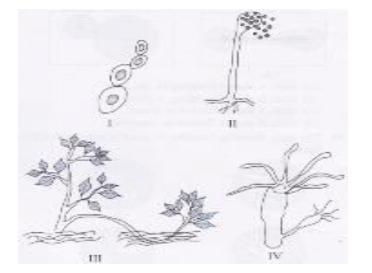Students can refer to questions for Biology Practical Class 10 based Questions. The questions are really useful and can help you to get more marks in Biology Practical Class 10 exams. All questions and answers provided below have been designed based on the latest Class 10 Biology syllabus and examination guidelines issued by CBSE, NCERT, and KVS. Students should also refer to Class 10 Science notes to get a better understanding of concepts
Biology Practical Class 10 based Questions
GENERAL INSTRUCTIONS:
Read the following instructions very carefully and strictly follow them:
(i) There are 20 questions and all questions are compulsory.
(ii) Questions 1 to 15 are of 1 mark and comprises of multiple-choice questions.
(iii) Questions 16 to 20 are of 2 marks and comprises of short answer questions.
Question 1. The diagram given below is the experimental set-up to show that carbon dioxide is given out during respiration. In this set-up what does the test tube marked (X) contain?

(a) Water
(b) Lime water
(c) Potassium hydroxide
(d) Hydrochloric acid
Answer. (c) Potassium hydroxide
Question 2. The seeds used in experiment to show that carbon dioxide is given out during respiration are:
a) dry seeds
b) boiled seeds
c) crushed seeds
d) germinating seeds
Answer. (d) germinating seeds
Question 3. In the experimental set-up, KOH solution has been kept in the flask to:

(a) react with water to generate oxygen.
(b) create a dry atmosphere for wet germinating seeds.
(c) absorb carbon dioxide so as to create a partial vacuum.
(d) remove impurities present in the air in the flask.
Answer. (c) absorb carbon dioxide so as to create a partial vacuum
Question 4. Out of the four experimental set-ups shown below, which one will demonstrate the evolution of carbon dioxide during respiration of germinating seeds:

(a) A
(b) B
(c) C
(d) D
Answer. (d) diagram D is correct because KOH is taken in small test tube
Question 5. The type of respiration shown by the germinating seeds to release carbon dioxide is:
(a) Anaerobic respiration
(b) Aerobic respiration
(c) oxidative phosphorylation
(d) Incomplete oxidation
Answer. (b) Its aerobic respiration takes oxygen and releases carbon dioxide
Question 6. In an airtight experimental set-up which was used by you in the laboratory to study respiration in germinating seeds, the seeds obtained the oxygen for respiration from:
(a) air in the flask
(b) water in the beaker
(c) water in the germinating seeds
(d) water used for soaking the seed
Answer. (a) air in the flask
Question 7. Which of the following substance is used to make all connections air tight in the experiment to show that carbon dioxide is produced during respiration:
(a) oil
(b) Vaseline
(c) ghee
(d) wax
Answer. (b) Vaseline
Question 8. Name the cell components required for completion of aerobic respiration in a cell.
(a) Chloroplast and nucleus
(b) Ribosomes and ER
(c) Golgi body and lysosomes
(d) Cytoplasm and mitochondria
Answer. (d) Cytoplasm and mitochondria
Question 9. Mention the sequence of budding in hydra:

Correct sequence is
(a) A, B, C, D
(b) A, D, B, C
(c) C, A, B, D
(d) D, A, B, C
Answer. (a) A, B, C, D
Question 10. Which of the following is not a feature of asexual reproduction?
(a) Two individuals of different sexes involved.
(b) No meiosis occurs.
(c) New individuals are genetically identical to the parents. .
(d) Offsprings are clones of parents.
Answer. (a) Two individuals of different sexes involved.
Question 11. Out of the following diagrams which one depicts a stage in binary fission of Amoeba?

(a) A
(b) B
(c) C
(d) D
Answer. (d) D
Question 12. The following figures illustrate binary fission in Amoeba in an incorrect sequence.

The correct sequence is:
(a) (i), (iii), (iv), (ii)
(b) (ii), (iii), (iv), (i)
(c) (iv), (iii), (ii), (i)
(d) (iii), (iv), (ii), (i)
Answer. (b) (ii), (iii), (iv), (i)
Question 13. What do F and E represent in the given diagram?

(a) Parent yeast cells
(b) Daughter Amoebae
(c) Yeast buds
(d) Parent Amoebae
Answer. (b) Daughter Amoebae
Question 14. Two of the following four figures that illustrates budding are:

(a) I & II
( b) I & III
( c) I & IV
(d) II & IV
Answer. (c) I & IV
Question 15. A chain of yeast cells are formed because:
(a) yeast cells do not separate after budding*
(b) daughter cells are unable to survive without parent cells
(c) buds reproduce as soon as they are formed
(d) daughter cells stick together with the help of mucus
Answer. (a) yeast cells do not separate after budding
Question 16. After observing the prepared slides of binary fission in Amoeba and budding in yeast, the following observations were reported:
a. Single cells of Amoeba and Yeast were undergoing binary fission and budding respective
b. Cytokinesis was observed in the Yeast cell.
c. Elongated nucleus was dividing to form two daughter nuclei in Amoeba.
d. A chain of buds were observed due to reproduction in Amoeba. The correct observation(s) is/are:
(a) d, a and c
(b) c and d
(c) b only
(d) a and c
Answer. (d) a and c
The correct observations are: i. Single cells of Amoeba and Yeast were undergoing binary fission and budding respectively. ii. Elongated nucleus was dividing to form two daughter nuclei in Amoeba.
Question 17. The following are the sketches of budding in yeast made by some students:

i) Which of the sketch is not illustrative of budding in yeast is :
(a) I
(b) II
(c) III
(d) IV
ii) Write the possible reason?
Answer. i) (c) III
ii) Figure ‘C’ shows complete individual yeast cell not budding.
Question 18. The figures given are drawn from slides showing reproduction in yeast and Amoeba. What correct description can be given to these figures?

Answer. (a) Amoeba undergoing binary fission is at a stage when nucleus is elongating, while yeast has undergone budding.
Question 19. A student is to conduct an experiment to show CO2 is released during respiration. List two precautions that he/she must take for obtaining correct observation.
Answer. Two precautions to be taken are:
(i) Germinating seeds (living) should be used.
(ii) The experiment set up must be air-tight.
Question 20. Students were asked to observe the permanent slides showing different stages of budding in yeast under high power of a microscope.
(a) Which adjustment screw (coarse/fine) were you asked to move to focus the slides?
(b) Draw three diagrams in correct sequence showing budding in yeast.
Answer. (a) A fine screw is used to focus the slides of budding in yeast under high power of a microscope.
(b) Sequence showing budding in yeast:

We hope you liked Biology Practical Class 10 based Questions provided above. Please let us know if you have any questions and problems in Biology Practical Class 10.


